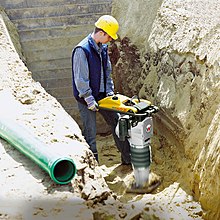Vibratory tamper

A vibrating tampers (also rammers , Rüttelstampfer , tamping machine or Wacker Stampfer ) is a machine work device for ground compaction of soil . When it is used, the device's multi-spring oscillation system converts the rotating movement of its internal combustion or electric motor into an upward and downward movement. This is transferred to a relatively large plate attached to the lower end of the device, which makes the plate two to eight centimeters off the ground.
The vibratory rammer is used in road construction , civil engineering , gardening and landscaping . There it is the tool for small areas and mainly coarse-grained, mixed-grained or cohesive soil (topsoil, earth, clay); For larger areas and non-cohesive soils (sand, gravel), a vibrating plate or roller is used. The manually operated hand ram can be used for very small areas .
The advantage of a vibratory rammer compared to the plate compactor is its maneuverability, which allows work in confined spaces, as well as its low weight and low center of gravity, which ensure easy handling and easy transport.
The vibratory tamper is held by a person on a handlebar. A motorized pad foot on the lower part of the device moves rhythmically up and down to compact the ground. The drive unit, the motor with an output of around 3 HP and the gearbox are located between the guide bracket and the foot section .
history
The electrical engineer Hermann Wacker developed the first Wacker rammer with an electric drive . In 1930, the Wacker company produced the first electric rammer. The term “wackern” was sometimes used instead of the word “stamping” on construction sites.